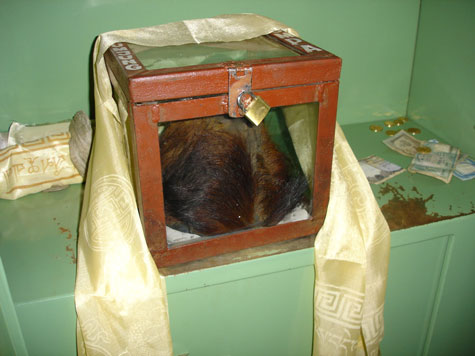Find the hands and scalp Snowman
In Pangboche Monastery (Nepal) there is a version of 'Yeti hand' and a very strange scalp, which seems to belong to the Snowman.
Russia's KM page said, the first time people discovered these artifacts was in 1950, but the prototype was stolen in 1990. Currently, a New Zealand pilot named Mike Olson has decided create the bone version of artifacts and bring them back to the monastery.

The scalp stored in the monastery is said to be of the Snowman.
In 1950, Peter Birna led the expedition to trace the Snowman at the foot of the Himalayas to find that the exhibits at the monastery did not look like human hands or any primates (especially about size). He also touched the scalp directly, and at the time he thought that this artifact belonged to a goat or a zebra.
The palm of the hand, even the experienced scientists of Oxford University cannot determine which species.
We note that the Snowman hypothesis, according to the ethnographic point of view, whether Asians, Europeans or Americans are very similar (in shape, physicality, habits, ways of being .). It is the image of the giants, hairy, shy but with extraordinary strength, living alone, in caves in deep forests and always hiding, so it is difficult to hunt or meet.
- Hot sun raises the risk of scalp fungus
- Scientists claim: The snowman is real
- Shoot the image of Snowman in Russia
- Causes of dandruff on the scalp
- Indian troops claim to have found evidence of mysterious snowmen
- Explore the snowman mystery with DNA technology
- 'Deciphering the snowman' mystery
- Controversy about the snowman's fur
- Find the shelter of Yetis Snowman in Russia
- Is it a piece of dry scalp?
- 'The hairy man' hidden in Russia in a row
- The truth about the bones and hairs of the snowman
 Discovered an ancient centipede fossil 99 million years old
Discovered an ancient centipede fossil 99 million years old Discovered bat-like dinosaurs in China
Discovered bat-like dinosaurs in China Discovered a 200-year-old bronze cannon of the coast
Discovered a 200-year-old bronze cannon of the coast Discover 305 million-year-old spider fossils
Discover 305 million-year-old spider fossils